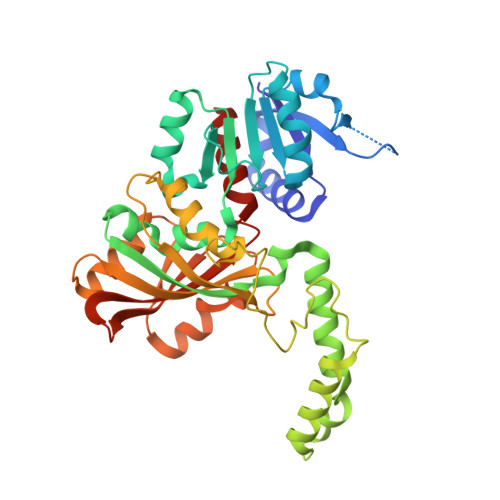The role of substrate-binding groups in the mechanism of aspartate-beta-semialdehyde dehydrogenase.
Blanco, J., Moore, R.A., Faehnle, C.R., Coe, D.M., Viola, R.E.(2004) Acta Crystallogr D Biol Crystallogr 60: 1388-1395
- PubMed: 15272161
- DOI: https://doi.org/10.1107/S0907444904012971
- Primary Citation of Related Structures:
1OZA, 1PQP, 1PQU, 1PR3, 1PS8, 1PU2, 1Q2X - PubMed Abstract:
The reversible dephosphorylation of beta-aspartyl phosphate to L-aspartate-beta-semialdehyde (ASA) in the aspartate biosynthetic pathway is catalyzed by aspartate-beta-semialdehyde dehydrogenase (ASADH). The product of this reaction is a key intermediate in the biosynthesis of diaminopimelic acid, an integral component of bacterial cell walls and a metabolic precursor of lysine and also a precursor in the biosynthesis of threonine, isoleucine and methionine. The structures of selected Haemophilus influenzae ASADH mutants were determined in order to evaluate the residues that are proposed to interact with the substrates ASA or phosphate. The substrate Km values are not altered by replacement of either an active-site arginine (Arg270) with a lysine or a putative phosphate-binding group (Lys246) with an arginine. However, the interaction of phosphate with the enzyme is adversely affected by replacement of Arg103 with lysine and is significantly altered when a neutral leucine is substituted at this position. A conservative Glu243 to aspartate mutant does not alter either ASA or phosphate binding, but instead results in an eightfold increase in the Km for the coenzyme NADP. Each of the mutations is shown to cause specific subtle active-site structural alterations and each of these changes results in decreases in catalytic efficiency ranging from significant (approximately 3% native activity) to substantial (<0.1% native activity).
Organizational Affiliation:
Department of Chemistry, University of Toledo, Ohio 43606, USA.
















